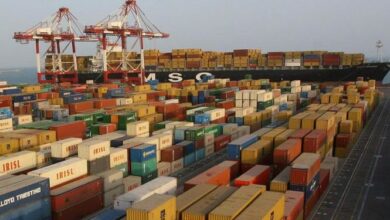U.S. Boosts Crude Sales to China, Forcing Saudis to Find Other Markets

The U.S. is quickly ramping up oil sales to China, the world’s biggest importer, forcing traditional suppliers in the Mideast to look for new markets or hold on to their crude in an already oversupplied world.
The U.S. accounted for 7% of Chinese crude imports through mid-September, according to London-based market intelligence firm Vortexa Ltd—up from 0.4% in January. Meanwhile, market share for Saudi Arabia, China’s biggest traditional supplier, fell to 15% from 19% in the same period. Based on recent tanker data, U.S. exports to China are expected to reach as much as 700,000 barrels a day at the end of October, forecasts Virginie Bahnik, a senior analyst at Geneva-based Petro-Logistics SA.
Earlier this year, China agreed to buy U.S. crude as part of a broader deal meant to ease rising trade tensions between the two world powers. The Trump administration agreed to cut some tariffs on Chinese goods in exchange for purchases of American farm, energy and manufacturing exports.
China’s buying so far is a long way from fulfilling commitments made in that deal, and to some extent it is simply restoring crude flows that were cut off amid the earlier U.S.-China trade tensions. As part of a deal, Beijing agreed in January to buy $52.4 billion worth of oil and liquefied-natural-gas from the U.S. by the end of 2021. The buying was delayed by the outbreak of the Covid-19 pandemic, but has ratcheted up more recently.
“The Chinese had to catch up,” said Petro-Logistics Chief Executive Daniel Gerber. That is now upending traditional oil-trade routes world-wide and further depressing some prices. Global prices have been hammered by falling demand caused by the pandemic.
Amid the new U.S. shipments to China, Saudi Arabia recently cut prices for its crude for buyers in Asia, a move that could make that oil more attractive to other regional buyers. It is also now resorting to storing unsold oil at home and overseas, including at depots in Egypt, Singapore and China. Saudi Arabia’s domestic crude-oil inventories rose 7% to 81 million barrels in the two weeks to Sept. 20, a level not seen since June, said Paris-based commodities-analysis company Kayrros.
Exports from other Mideast producers to China are also being hit. Shipments from Gulf Cooperation Council countries—excluding Saudi Arabia—fell by at least 400,000 barrels a day, to 1.6 million barrels in September, compared with their average levels in April to July, according to Petro-Logistics.
The energy ministries of Saudi Arabia, Oman and the United Arab Emirates and the Kuwait oil ministry didn’t return requests for comment. A Saudi energy adviser said the shift is “only temporary.”
The Chinese-U.S. deal expires at the end of next year, and Chinese refineries have historically been fueled by Middle Eastern, Russian and West African grades. A change of administrations after U.S. elections next month, or a change of tack by a re-elected President Trump, could threaten continued buying. That is especially the case amid fresh economic and geopolitical skirmishes between Washington and Beijing, including the Trump administration’s offensive against Chinese tech giants such as Huawei Technologies Co. and ByteDance, the owner of TikTok.
An abundance of fossil fuels combined with advances in technology to harness wind and solar power has sent energy prices crashing around the world. WSJ explains how it all happened at once. Photo illustration: Carlos Waters/WSJ
But some analysts say that after some Chinese refineries retooled their plants to process U.S. grades, they may keep buying.
“Does the U.S.-to-China trade have staying power?” said Clay Seigle, who runs Vortexa’s Houston office. “It probably does now that Chinese refiners have established demand for U.S. grades.”
That is good news for U.S. suppliers, who have struggled like the rest of the world’s producers with low oil prices. Amid sharply lower demand, prices have dropped about 34% since the start of the year, and are now trading around $40 a barrel.
A foothold in the Chinese market gives U.S. shale companies in particular an outlet that had closed off when the U.S.-China trade fight was in full swing last year.
“That certainly helps American producers,” said Manish Raj, chief financial officer at Velandera Energy Partners LLC, a U.S. oil-and-gas producer operating in Louisiana.
Sandy Fielden, an analyst at Morningstar Inc., said the deal has helped cushion some American suppliers amid the downturn. “If [the crude] wasn’t going to export,” he said, “there’d be no place for it domestically, and it’d be causing a great deal more pain for producers.”





